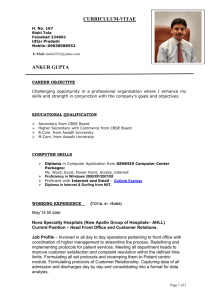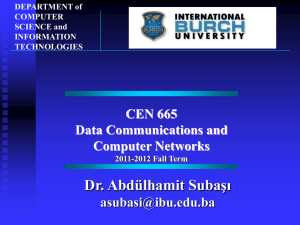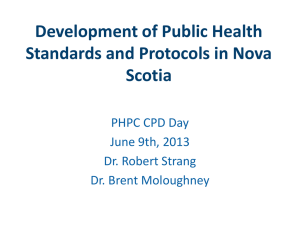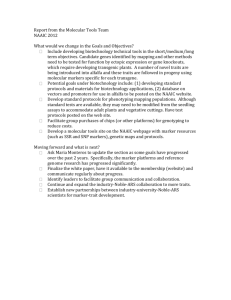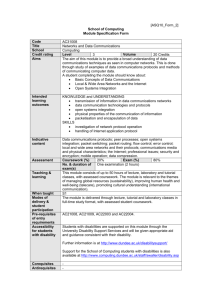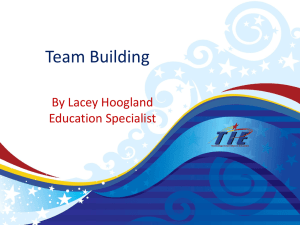Facilitator`s Guide: Using Protocols Purposefully
advertisement
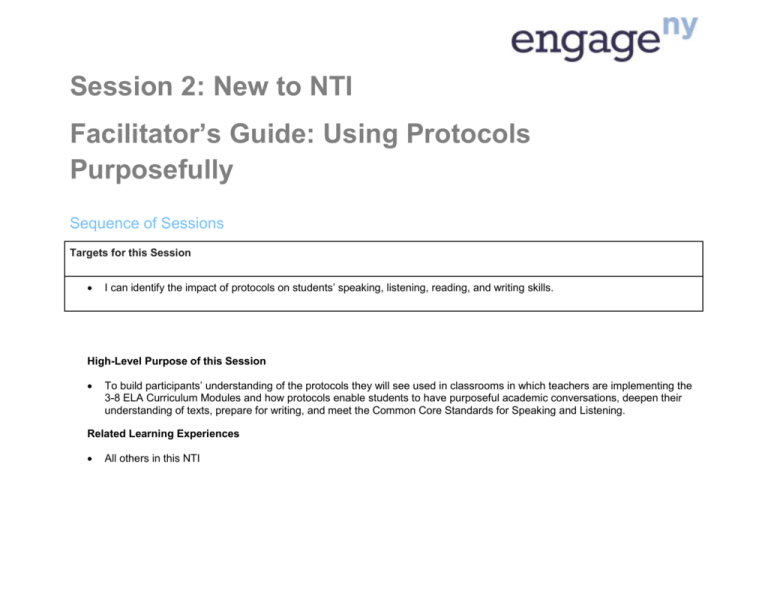
Session 2: New to NTI Facilitator’s Guide: Using Protocols Purposefully Sequence of Sessions Targets for this Session I can identify the impact of protocols on students’ speaking, listening, reading, and writing skills. High-Level Purpose of this Session To build participants’ understanding of the protocols they will see used in classrooms in which teachers are implementing the 3-8 ELA Curriculum Modules and how protocols enable students to have purposeful academic conversations, deepen their understanding of texts, prepare for writing, and meet the Common Core Standards for Speaking and Listening. Related Learning Experiences All others in this NTI Key Points The EL Curriculum Modules include protocols and other collaborative structures to meet the demands of the Common Core. Protocols enable students to have purposeful academic conversations and meet the Common Core Standards for Speaking and Listening. Protocols deepen students’ understanding of text and help them build knowledge that leads to effective writing. Session Outcomes What do we want participants to be able to do as a result of this session? I can identify the impact of protocols on students’ speaking, listening, reading, and writing skills. How will we know that they are able to do this? Participants will observe protocol videos using the New York CCSS Instructional Practice Guides and a notecatcher and engage in group discussions. Session Overview Section Time Overview Greetings and Group Grounding 10 min Participants will journal in response to quote about academic conversation. They are introduced to session targets Prepared Resources Participant’s Notebook Zweirs’ quote Facilitator’s Guide PPT_2N_Protoc_NTI714 Facilitator’s Preparation Review facilitation guide and PowerPoint. Familiarize yourself Protocols in 60 Action Reflection 5 min Participants complete the New York CCSS Instructional Practice Guides as they observe videos of protocols in action. Participant’s Notebook about effective protocol use. Concentric (Debrief) Circle: https://www.teachingchannel.org/videos/studentsreflect-on-learning-exl Interactive Word Walls: http://vimeo.com/84900192 Quiz-Quiz-Trade: http://vimeo.com/76172830 Science Talk: http://vimeo.com/76178452 Protocols in Action _2N_NTI714.pdf Instr_Pract_Gde_6-12.pdf Instr_Pract_Gde_3-5.pdf PPT_2N_Protoc_NTI714 Implementing the Modules: School Leader Notecatcher (continued from Session 1 Notecatcher_1N_NTI714.pdf) with all of the protocols and techniques from Appendix 1. Watch all of the protocol videos and review the “New York CCSS Instructional Practice Guides.” You will need sticky notes or index cards for the GoGoMo protocol. Session Roadmap Section 1: Greetings and Group Grounding Time: 11:15-11:25am [10 minutes] In this section, you will prepare participants for the session and create a culture of achievement. Materials used include: Time Slide #/Pic of Slide 1 min PPT Slide # 2 Participant’s Notebook Facilitator’s Guide PPT_2N_Protoc_NTI714 Quick-Write_2N_NTI714.pdf Script/Activity directions Ask a participant to read aloud the following quote: Grouping Whole Group “Talking with others is a powerful way to learn--and is a vital life skill. In academic conversations, students explore ideas and negotiate meanings to deepen understandings and connections.” (Zweirs, 2010) 3 min PPT Slide # 3 5 min PPT Slide # 4 1 min PPT Slide # 5 Ask participants to journal in their Participant’s Notebook about this quote: “How can conversations about text deepen students’ understanding and help prepare them for writing? How do your teachers support meaningful academic conversations in their classrooms? What are the challenges they face in doing so effectively?” Participants introduce themselves to their tablemates, sharing one thought from their quick-write. (A sentence, not a paragraph.) Facilitator introduces the learning targets for the session. Section 2: Observing, Collecting Evidence, and Reflecting on Protocols in Action Time: 11:25- 12:25 [60 minutes] In this section, participants will have the opportunity Materials used include: to observe several protocols in use in classrooms while collecting Concentric (Debrief) Circle: evidence using the New York CCSS Instructional Practice Guide. https://www.teachingchannel.org/videos/students-reflectParticipants will be invited to reflect upon the support teachers on-learning-exl might need in implementing these new instructional practices. Interactive Word Walls: http://vimeo.com/84900192 Quiz-Quiz-Trade: http://vimeo.com/76172830 Science Talk: http://vimeo.com/76178452 Time Slide #/Pic of Slide 2 min PPT Slide # 6 Script/Activity directions 3 min PPT Slides # 7-8 Protocols in Action _2N_NTI714.pdf Sticky notes Grouping Whole group Frame the session by reminding participants about some of their conversations during Session 1 related to the practices found in the module lessons that may be different than those they currently see when doing classroom observations. Tell participants that the Common Core Speaking and Listening Standards require students to engage in academic conversations with a variety of partners about a variety of topics. Invite a participant to read the following quote aloud while other participants follow along: “Students must have ample opportunities to take part in a variety of rich, structured conversations—as part of a whole class, in small groups, and with a partner—built around important content in various domains. They must be able to contribute appropriately to these conversations, to make comparisons and contrasts, and to analyze and synthesize a multitude of ideas.” Tell participants that Expeditionary Learning’s curriculum Whole group includes structures to facilitate these conversations and that the structures are embedded within the lesson plans as “Protocols.” Introduce the concept of protocols with Slide 7 by saying something like, “Protocols are discussion ‘rules’ that provide structured, engaging, consistently used forums for students to discuss their learning. They can be used to introduce, clarify, support, and reinforce both learning content and process. The consistent use of a select set of discussion protocols establishes an efficient classroom learning community in which ideas and opinions are shared frequently and in an orderly, timely manner.” 6 min PPT slides # 9-11 Transition participants into their role for this portion of the session by telling them that they now get to learn more about protocols by observing several protocols in action. Direct participants to the New York CCSS Instructional Practice Guides located in their Participant’s Notebooks. Tell participants that these guides are particularly useful for coaching and peer observation, because we know that principals have other rubrics that they are required to use. We are using it today as a means to focus our work in on the shifts necessitated by the Common Core. Tell participants that there are two different Instructional Practice Guides: One for grades 3-5 and one for grades 612. They will be using both today, as some of the videos are in elementary classrooms and others are in secondary. Instruct participants to access the New York CCSS Instructional Practice Guide for Grades 3-5 first and point out the three core actions that should be apparent in daily ELA lessons. Allow participants to read through the guide. (2 minutes) After participants are finished, let them know that because the videos they will be watching will only provide very small glimpses into lessons, we won’t be asking them to gather evidence on this guide today. Instead, we will ask them to keep the core actions in mind as they observe protocols in action and take notes using a different notecatcher. Introduce the Protocols in Action Notecatcher by walking participants through each column: Student Engagement – Does this protocol engage one, some, or all students in a class? Strength of Protocol – What are the benefits of using this protocol? What does this protocol achieve that a more traditional practice might not? Core Action(s) Evident – For which of the Core Actions from the Instructional Practice Guide were Whole group 22 min PPT slides # 12-19 6 min PPT slide # 20 6 min PPT slide # 21 10 min PPT Slide # 22 5 min PPT slide # 23 you able to collect some evidence? There is a reminder about the three Core Actions at the bottom of this notecatcher. Check for understanding and invite clarifying questions from participants regarding video observation task. Play each of the four Protocol videos. After each video, instruct participants to complete the row of the chart on their Notecatcher for that protocol. Invite participants to share out in large group in response to the prompt: How can the use of these protocols support students as they develop speaking, listening, reading, and writing skills? Tell participants to take a couple of minutes to independently answer the questions at the bottom of their notecatchers: “What structures will teachers need to have in place in order to use protocols successfully with students? What support can you provide your teachers as they work to implement protocols?” (4 minutes) Direct participants to transfer their answer to question 2 to sticky notes found on their tables (2 minutes) [Facilitator’s Note: Remind participants that they will eventually be giving each of their cards to another participant so they should be sure to write legibly]. Introduce participants to the GoGoMo (Give One, Get One, Move On) Protocol. Adhering to the protocol, participants will share out one of their ideas for supporting teachers in implementing protocols to another participant (not someone from their table). (1 minutes per person, 2 minutes per pair). [Facilitator Note: You will be the master timekeeper for this. After the first pairs have formed, start time for two minutes. After two minutes, yell “Move On” so that participants find a new partner. Repeat the process three times before instructing participants to return to their original table groups.] Facilitate a brief share out in response to the questions: What insights or ideas emerged for you from your Whole group Whole group Solo; pairs Whole group discussions about supporting teachers in the use of protocols? How did using GoGoMo support your own conversations? Mention to participants that one of the reasons we engaged in GoGoMo was to model a protocol in action. Share that in some schools that have been implementing the modules, school leaders have been using protocols with staff as a way to model expectations. Not only does this provide a great example for teachers using the modules, but it introduces collaborative structures to teachers of all content areas. Most of the protocols used in the modules can be adapted for use in any subject. Have participants locate the EL Appendix Protocols and Resources document Tell participants that this resource is a collection of all of the protocols found throughout the module lessons. Encourage participants to identify one a two protocols to use during their Back-to-School staff meetings in September Section 3: Reflection and Closing Time: 12:25-12:30pm [5 minutes] Participants synthesize learning about effective protocol use and identify next steps for implementation. Materials Used Include: Time Slide #/Pic of Slide 5 min PPT Slides # 24-25 Participants’ Notebook Script/Activity directions Direct participants back to their original quick-write from the session. Ask them to add their current thinking. Ask, “How Grouping Solo can conversations about text deepen students’ understanding and help prepare them for writing? How do your teachers support meaningful academic conversations in their classrooms? What are the challenges they face in doing so effectively?” Remind participants that their notecatcher from Session 1 included a row for “Protocols.” In closing, participants should add notes to that row. Turnkey Materials Provided Facilitator’s Guide and PowerPoint Appendix 1 (Protocols & Assessment Techniques) from the ELA Modules Protocols in Action_2N_NTI714.pdf Quick-Write_2N_NTI714.pdf Using Protocols_2N_NTI714.pdf Links to protocol videos: o Concentric (Debrief) Circle: https://www.teachingchannel.org/videos/students-reflect-on-learning-exl o Interactive Word Walls: http://vimeo.com/84900192 o Quiz-Quiz-Trade: http://vimeo.com/76172830 o Science Talk: http://vimeo.com/76178452


